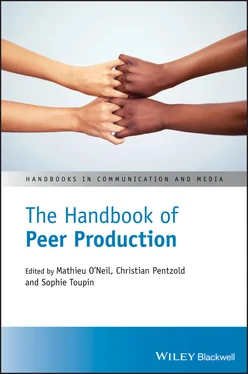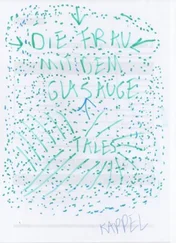Institutions enable the conversion of the freedom gained from a number of legal and managerial restrictions into a freedom achieved for productive participation (Berlin, 1969). This chapter charts and discusses rules and norms as potentially conducive “forms of closure” (Tkacz, 2016, p. 33) in peer production. This sounds oxymoronic, yet it points to a fundamental friction between, on the one hand, the ambition to open forms of cooperation that are less restricted by property rights or hierarchical structures and, on the other, the need to establish rules that close activities set to violate this openness.
The overview offered in this chapter starts from the idea that voluntary, commons‐based cooperation needs some kind of ordering and that institutions can help to organize the freedom of action found within peer production. Following the social constructivism of Berger and Luckmann (1966), the chapter assumes that institutionalization happens whenever people interact in a more habitual manner. Institutions such as norms and rules thus hint at the typification, habitualization, and ordering of social action. De‐institutionalization, in turn, occurs through the transition of rules or norms into new contexts or when their original setting changes. Regulations can also be altered by strategic efforts. Furthermore, institutions might be transformed due to conflicting rulings or dissenting normative expectations (Oliver, 1992; Zucker, 1977). For instance, in her study of the Debian community of programmers, Coleman (2013) finds what she calls moments of “punctuated crisis” (p. 124). There, the conflicting modes of governance of democratic majoritarian rule, a guildlike meritocracy, and an ad hoc process of rough consensus clash and prompt negotiations and new rulings.
The chapter is organized along a set of questions. The second part asks why peer production needs any sort of rules and norms. Based on this discussion of institutional conditions, the third part will map what sorts of rules and norms prevail in peer production. It delineates the three institutional levels of policies, guidelines, and basic normative understandings that are geared towards the products and the processes of peer production. Next, the fourth part examines how rules and norms come into existence and are made to function. Finally, the chapter reflects to what end peer production’s institutions congeal into governance regimes, bureaucracy, and hierarchies.
The chapter mostly refers to Wikipedia and free and open source software projects such as Linux and Debian (see also Couture, this volume; Haider & Sundin, this volume). These paragons showcase the power and potential of peer production. They are taken as reference cases since these mature initiatives provide rich information about the long‐term processes of building and transforming institutions for voluntary and free cooperation.
2 Why Rules and Norms? Institutional Conditions for Peer Production
Rules and social norms play an important part in organizing peer production. Given the anonymity, ease of entry, and limited social cues which characterize peer projects, this can be a challenging mission (Resnick & Kraut, 2011). In that respect, institutions can be seen as an answer to the question of “how to steer the integration of dispersed knowledge resources and how to coordinate such activities to the purpose of creating common value” (Aaltonen & Lanzara, 2015, p. 1650). They provide for the collective capability of participants separated in space and time to bundle together the piecemeal contributions and direct them towards the joint production of a valuable outcome. In order to continuously create and ensure collective agency, rules and social norms can rarely be one‐time solutions. They have to be adapted to the dynamics of a particular project, for instance, in terms of new user cohorts, content growth, or a changing technological and legal environment.
Scott (2001) defines institutions as “multifaceted, durable, social structures, made up of symbolic elements, social activities, and material resources” (p. 49). Institutions are created because of “the development, recognition, and naming of a recurrent problem to which no existing institution provides a satisfactory repertoire of responses” (Scott, 2001, p. 96). In peer production institutions take the shape of formal regulations, informal social norms, as well as shared actions and evaluations. Furthermore, institutions are encoded requirements and courses of activity embedded in software and hardware (de Laat, 2007; Markus, 2007; O’Mahony & Ferraro, 2007; Schroeder & Wagner, 2012). The institutional ecology of cooperation is established in order to protect the integrity of projects.
Most notably, the idea of freedom is enshrined in licenses such as the General Public License or the Creative Commons License (Lakhani & von Hippel, 2003; Lessig, 1999; Raymond, 1999; Stewart & Gosain, 2006; Vieira & de Filippi, 2014; see also Dulong de Rosnay, this volume). In projects such as the Linux kernel operating system, they guarantee some of the pivots of peer production and safeguard its essential modes of operation that rest on sharing, copying, adapting, and disseminating incremental contributions. This backbone is charged with a normative impetus, namely, that proprietary software “is antisocial, that it is unethical, that it is simply wrong,” as Richard Stallman (2004) exclaimed. This again rests on the moral idea of a hacker culture where all information should be free and decentralization ought to be promoted so as to change life for the better (Levy, 1984).
Institutions are an ill‐defined category. Following Scott (2001) we can distinguish “three pillars of institutions” (p. 51). They encompass regulations, norms, as well as conventional orders of knowledge and action (DiMaggio & Powell, 1991). Regulative rules come as provisions, statutes, laws or decrees that specify how an activity must be executed. They imply monitoring and enforcement through sanctions or gratifications that either penalize deviant behavior or reward compliance. In peer production projects, rules are vital resources to draw on in order to justify as well as to challenge a decision or action (Bryant, Forte, & Bruckman, 2005; Lakhani & Von Hippel, 2003; Pentzold, 2017, 2018; Viègas, Wattenberg, & Dave, 2004; Viègas, Wattenberg, & McKeon, 2007). Rules crystallize informal conventions or implicit standards in tangible written form and prompt what Giddens (1984) has called an instrumental behavior. It can mean conformity, yet other responses such as prevention, defiance, or forms of gaming the system might also pose viable options.
The application of formal regulations can be backed up by normative demands. Norms can be seen, according to Scott (2001), as “conceptions of the preferred or the desirable, together with the construction of standards of which existing structures or behavior can be compared and assessed” (p. 54f.). They usually take shape in maxims, sayings, or moral doctrines like the dictum that “All information should be free,” as documented by Levy (1984, p. 40) in his account of the hacker ethic. Because peer production projects only have a limited potential to enforce rules or prosecute wrongdoers due to their voluntary and open nature, they very much rely on informal norms (Raymond, 1999; Stewart & Gosain, 2006). Norms ideally do not need external sanctions because they encompass an obligatory moral request that takes effect by way of internalized commitment. In Max Weber’s (1978) terms, norms feature the “prestige of being considered binding, or, as it may be expressed, of ‘legitimacy’” (p. 31). Thus, while rules request an instrumental logic of individual interests and alternative ways to act, some of which are permitted while others are not, norms engender a logic of acceptability that is oriented towards an accordance of action and expectations (March & Olsen, 1989).
Читать дальше


![О Генри - Справочник Гименея [The Handbook of Hymen]](/books/407356/o-genri-spravochnik-gimeneya-the-handbook-of-hymen-thumb.webp)









